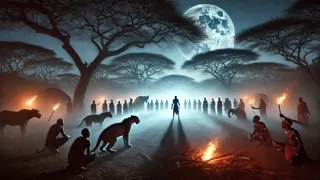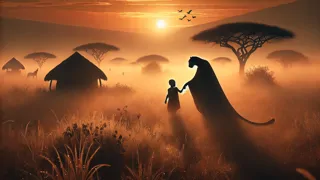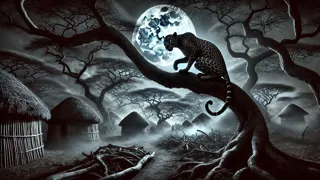Introduction
Under a moonlit Tanzanian sky, the acacia grove stirs with a restless hush. The fragrance of dry grass and distant wood smoke drifts on a cool breeze, weaving through the trees and settling over a sleeping village at the forest’s edge. In whispered tales passed among elders, there exists a being both feared and revered—the Leopard Man. He moves between realms, neither fully human nor wholly beast, with eyes that gleam like embers and claws that rend bone and skin. Legends say he was once a proud hunter with a heart hardened by ambition and cruelty, who bargained with ancestral spirits to wear the spots and strength of a leopard. His gift, however, became his curse: unable to temper his savage urges, he grew into a fearsome terror that no weapon could truly bind.
Throughout generations, mothers have hushed their children at twilight, reminding them to stay close to hearth and home, for the Leopard Man prowls hungry for blood and arrogance’s price. He has leapt from branch to thatch roof, spat curses in ancient tongues, and vanished like mist before dawn. Yet over time, the forest itself has begun to shift—lions grow bolder, leopards more restless, and hyenas howl with unnatural fury. Even the ancestors stir in their hidden groves, their patience nearing its end. As night deepens and the wind carries distant roars through the trees, the villagers tremble between dread and hope: will justice fall on the Leopard Man’s head, or will his dominion spread until even sunlight fears to touch his shadow?
The Whispered Legend
In the earliest memory of the villagers, the forest itself breathed with ancient power. They spoke of a hunter named Kaombi, whose skill was unmatched and whose pride eclipsed any caution. Walking the paths of his forefathers, he marked each kill with a ceremonial scar—proof of his mastery. Yet even as his reputation swelled, his heart tightened like a noose around mercy and respect for life.

At a dusk-touched gathering beneath the baobab, Kaombi first encountered the Leopard Spirit: a being of golden eyes and velvet fur, moving soundless among dancing embers. It offered him a pact in hushed tones that rustled like dry leaves. In exchange for a drop of his blood, he would take on its form, its strength, its cunning. Without hesitation, Kaombi slit his palm, vowed his loyalty, and drank the crimson promise. The world tilted. Bones reshaped. Muscles rippled. He rose as the Leopard Man—a creature of both realm and wild, with an appetite free from human restraint.
At first, the villagers rejoiced. Their protector could now fight the fiercest predators and shield them from rogue warriors seeking slaves. Word spread like sunfire, and neighboring clans hailed Kaombi’s name. But gifts ring hollow when wielded by cruelty. Under moonlight, he stalked the very beasts he once hunted for sport, tasted their blood to sate his arrogance, and marked their pelts with triumphant claws.
By dawn, hyenas fled his path, and elephants turned on their own herd in terror. Fruit fell from trees untouched, and waterholes ran dry as wildlife vanished. Mothers trembled, children cried, and even the bravest warriors whispered prayers into the dawn mist. Rumors darted through the thickets: Kaombi no longer served humanity. He served only himself, an apex predator on two legs. The fire that once united the village sputtered, replaced by the fear of a monster wearing its face.
Old Nyahombe, the village seer, spoke in low tones of the ancestral covenant broken. The forest’s heart wept. Stars above trembled. A reckoning brewed beneath the canopy that no blade could forestall.
The Forest’s Retribution
The winds carried a promise of storm long before thunder shook the sky. Animals once silent in the Leopard Man’s presence began to stir: baboons chattered urgent warnings, cattle refused to graze, and vultures circled low as if awaiting a spectacle. Deep in the oldest grove, the Spirit of the Land awakened, its roots quivering with fury. It reached out not in mercy, but in justice.

One night, as Kaombi stalked beyond the riverbank, he found himself ensnared in vines ancient as memory. They coiled around his legs, his arms, binding him where he stood. The world shimmered, and the stars above refracted into jagged shards. In that fractured sky, the Leopard Spirit appeared—no longer a silent ally, but an avenging sentinel. Its eyes glowed with ancestral wrath.
"You have tainted our covenant," it hissed in Kaombi’s mind. "You clothed yourself in our form, ate our kin, and turned our gifts into terror." The Leopard Man snarled, claws slashing at air and vine, but each swipe met only sinew and rotted wood.
Lightning split the canopy as the ancestral spirits rose in chorus: drummers of bone, horns of iron, voices echoing through the earth’s marrow. They summoned wind and rain, thunder and flame. The acacia grove blazed with primal energy. Animals answered the call: herds of gazelle stampeded through underbrush, buffalo charged with thunderous hooves, leopards themselves joined the hunt.
Kaombi howled as his form unraveled. Spots melted into flesh, claws shrank to nails, fury gave way to bone-weary terror. The forest’s judgment was neither swift nor merciful. It ground him down slowly: hunger gnawed at veins, thirst scorched his tongue, and terror chased him through roads of flame and riverbeds turned to ice. When the dawn came, he lay broken before the baobab, skin blackened, spirit hollow.
The villagers found him then and trembled, uncertain if they had glimpsed both hunter and hunted in equal measure. Even speechless priests dared not utter a blessing. They bound Kaombi in vines of woven prayer and left him at the forest’s edge—neither dead nor fully alive, a living warning etched onto the land.
The New Dawn
Years passed and the grove healed. New saplings pushed through as hyenas howled less urgently and the river once again welcomed thirsty herds. The villagers rebuilt their homes, planting seeds of maize and sorghum where the Leopard Man’s passage had burned the fields. They spoke of renewal, of the bond restored between humanity and the wild.

Yet on moonless nights, when the wind carried distant roars, some claimed they felt a presence at the edge of camp. A shifting silhouette that morphed between man and beast, lingering just beyond the lantern glow. Few dared follow its gaze—eyes once so fierce had softened, filled with profound remorse. In those silent moments, kinship bridged the divide: predator and prey, human and spirit, both bound by the cycle of respect and consequence.
Elder Nyahombe said that Kaombi lived still, wandering the forest as penance, guiding lost travelers back to safety, protecting orphans and abandoned calves alike. His claws, once instruments of terror, now cleared paths through thorn and brush. His spots, once a herald of dread, became draped in vines of remembrance.
By sunrise, he vanished into the golden grass, leaving only pawprints of hardened earth and a single leopard whisker. In that fragile gift lay a message for all who heard the tale: power granted without honor invites ruin, but even the deepest wrong can be transformed through humility and atonement.
So the villagers light a candle on the longest night and whisper a prayer of gratitude to the shape-shifter who learned mercy. They recall the Leopard Man’s tale not as a warning alone, but as a promise: that justice flows in both fury and forgiveness.
Conclusion
The Leopard Man’s legend endures in every rustle of the acacia leaves and every distant growl beneath the stars. It reminds us that the world’s balance hangs on respect—between hunter and hunted, human and spirit. Cruelty may grant power for a time, but it also sows the seeds of its own undoing. From Kaombi’s fall, we learn that true strength requires compassion, and that justice—once provoked—will not rest until wounded bonds are mended. In remembering his tale, we renew our own pledge: to honor the unseen forces that shape our lives, treat all beings with dignity, and heed the subtle voice of nature’s own justice.

















